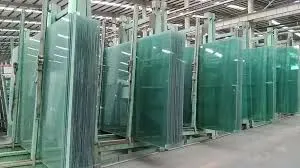Understanding the Types of Annealed Glass
Annealed glass is a type of flat glass that undergoes a specific heat treatment process known as annealing, aimed at relieving internal stresses that arise during the manufacturing phase. This process involves heating the glass to a temperature just below its melting point and then cooling it slowly in a controlled environment. The result is a stable and uniform glass product that is easy to cut and shape. In this article, we will explore the various types of annealed glass, their properties, and applications.
Types of Annealed Glass
1. Clear Annealed Glass
Clear annealed glass is one of the most common types on the market. It is transparent and colorless, providing excellent clarity and light transmission. This type is often used in residential windows, storefronts, and doors. Its aesthetic appeal and practical applications make it a popular choice for architects and builders.
2. Tinted Annealed Glass
Tinted annealed glass is produced by adding metal oxides during the manufacturing process, which gives the glass a color tint. This kind of glass reduces glare and improves energy efficiency by limiting solar heat gain. As a result, tinted annealed glass is commonly used in commercial buildings and skyscrapers to enhance visual comfort and reduce cooling costs.
3. Frosted Annealed Glass
Frosted annealed glass features a sandblasted or acid-etched surface that reduces transparency while maintaining light diffusion. This type is often used in bathrooms, office partitions, and decorative applications where privacy is essential. The frosted finish provides a stylish element to any space while ensuring adequate light transmission.
types of annealed glass
4. Laminated Annealed Glass
Laminated annealed glass consists of two or more layers of glass bonded together with an interlayer, typically made of polyvinyl butyral (PVB). This type of glass enhances safety and security, as it holds together even when shattered. Laminated glass is commonly used in skylights, glass doors, and windows in high-traffic areas to minimize the risk of injury from broken glass.
5. Low-E Annealed Glass
Low-emissivity (Low-E) annealed glass features a special coating that reflects heat while allowing visible light to pass through. This type significantly improves energy efficiency by reducing heat loss in winter and minimizing heat gain in summer. It is widely used in energy-efficient windows and building facades, making it a sustainable choice for modern construction.
6. Reflective Annealed Glass
Reflective annealed glass is coated with a thin layer of metal that reflects light, providing privacy and reducing glare. This type is often used in commercial buildings and skyscrapers, where aesthetics and energy efficiency are critical. The reflective surface not only enhances the building's appearance but also contributes to its thermal performance.
Conclusion
Annealed glass is versatile and widely used due to its durability and aesthetic appeal. Each type, from clear to tinted, frosted, laminated, low-E, and reflective, serves different purposes suited to various applications. Understanding these types can help consumers and professionals make informed decisions based on their specific needs, whether it be for architectural design, safety, energy efficiency, or privacy. With its unique properties and applications, annealed glass continues to play a vital role in modern construction and design.
 Afrikaans
Afrikaans  Albanian
Albanian  Amharic
Amharic  Arabic
Arabic  Armenian
Armenian  Azerbaijani
Azerbaijani  Basque
Basque  Belarusian
Belarusian  Bengali
Bengali  Bosnian
Bosnian  Bulgarian
Bulgarian  Catalan
Catalan  Cebuano
Cebuano  Corsican
Corsican  Croatian
Croatian  Czech
Czech  Danish
Danish  Dutch
Dutch  English
English  Esperanto
Esperanto  Estonian
Estonian  Finnish
Finnish  French
French  Frisian
Frisian  Galician
Galician  Georgian
Georgian  German
German  Greek
Greek  Gujarati
Gujarati  Haitian Creole
Haitian Creole  hausa
hausa  hawaiian
hawaiian  Hebrew
Hebrew  Hindi
Hindi  Miao
Miao  Hungarian
Hungarian  Icelandic
Icelandic  igbo
igbo  Indonesian
Indonesian  irish
irish  Italian
Italian  Japanese
Japanese  Javanese
Javanese  Kannada
Kannada  kazakh
kazakh  Khmer
Khmer  Rwandese
Rwandese  Korean
Korean  Kurdish
Kurdish  Kyrgyz
Kyrgyz  Lao
Lao  Latin
Latin  Latvian
Latvian  Lithuanian
Lithuanian  Luxembourgish
Luxembourgish  Macedonian
Macedonian  Malgashi
Malgashi  Malay
Malay  Malayalam
Malayalam  Maltese
Maltese  Maori
Maori  Marathi
Marathi  Mongolian
Mongolian  Myanmar
Myanmar  Nepali
Nepali  Norwegian
Norwegian  Norwegian
Norwegian  Occitan
Occitan  Pashto
Pashto  Persian
Persian  Polish
Polish  Portuguese
Portuguese  Punjabi
Punjabi  Romanian
Romanian  Russian
Russian  Samoan
Samoan  Scottish Gaelic
Scottish Gaelic  Serbian
Serbian  Sesotho
Sesotho  Shona
Shona  Sindhi
Sindhi  Sinhala
Sinhala  Slovak
Slovak  Slovenian
Slovenian  Somali
Somali  Spanish
Spanish  Sundanese
Sundanese  Swahili
Swahili  Swedish
Swedish  Tagalog
Tagalog  Tajik
Tajik  Tamil
Tamil  Tatar
Tatar  Telugu
Telugu  Thai
Thai  Turkish
Turkish  Turkmen
Turkmen  Ukrainian
Ukrainian  Urdu
Urdu  Uighur
Uighur  Uzbek
Uzbek  Vietnamese
Vietnamese  Welsh
Welsh  Bantu
Bantu  Yiddish
Yiddish  Yoruba
Yoruba  Zulu
Zulu 

